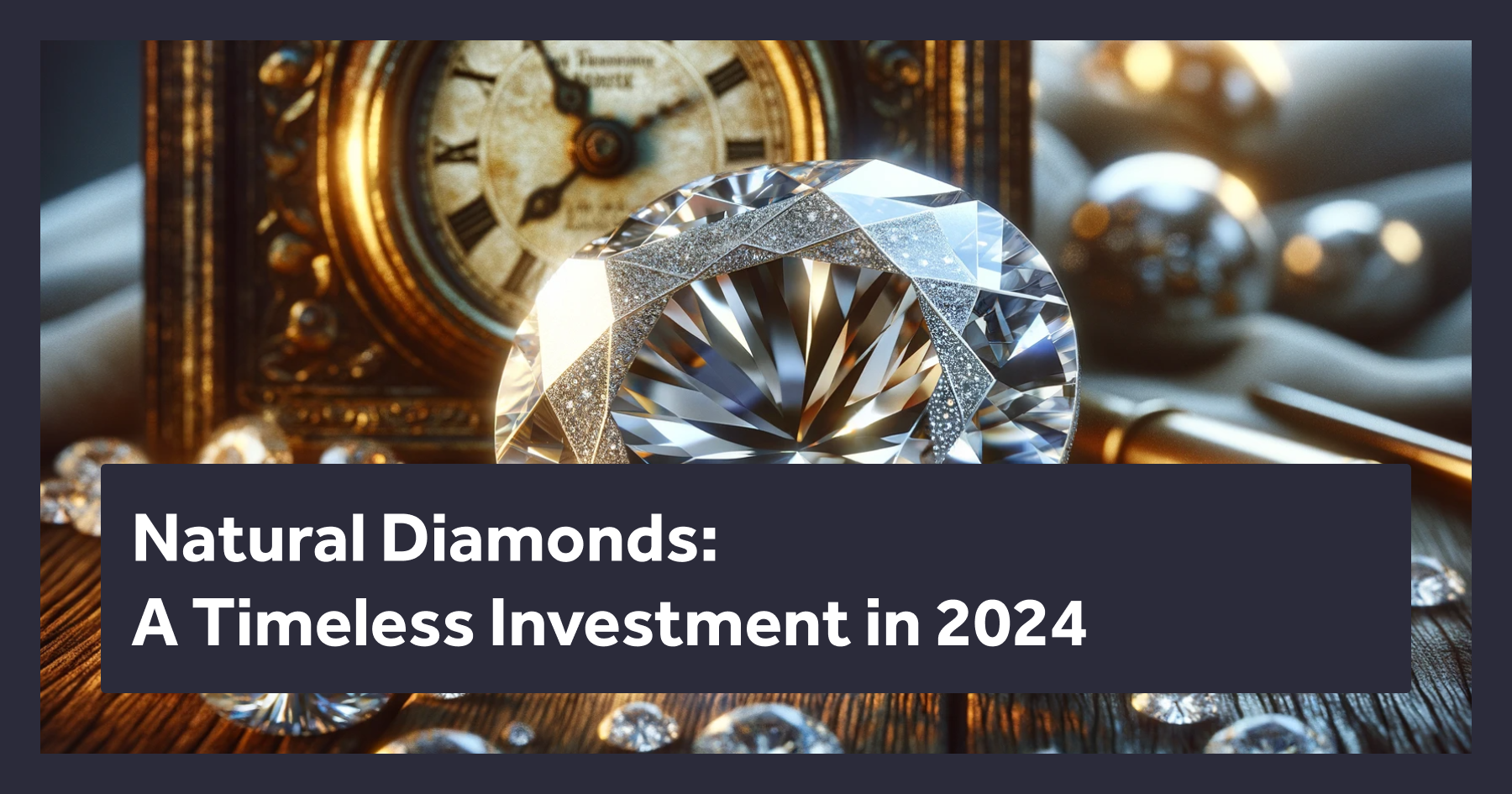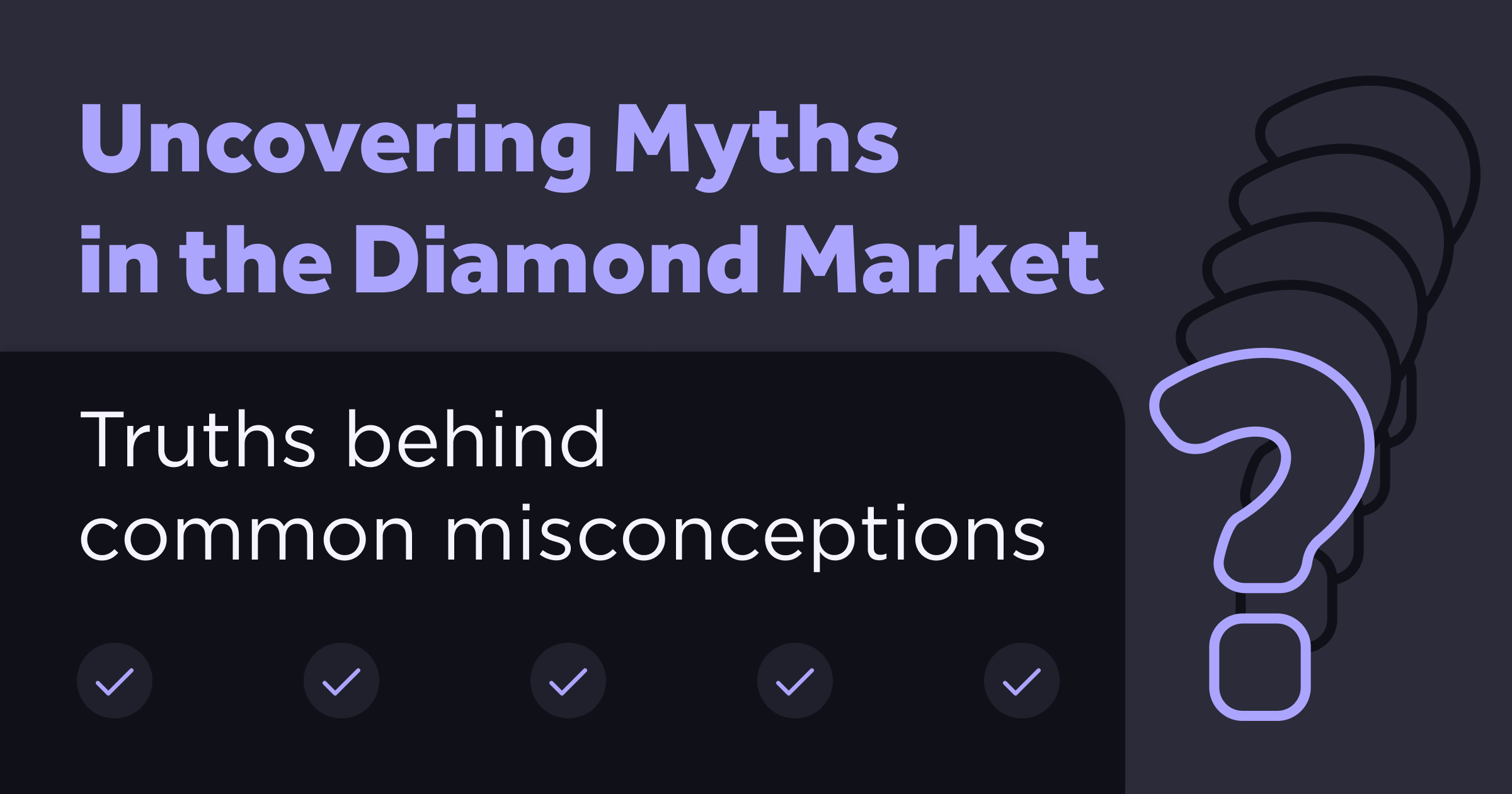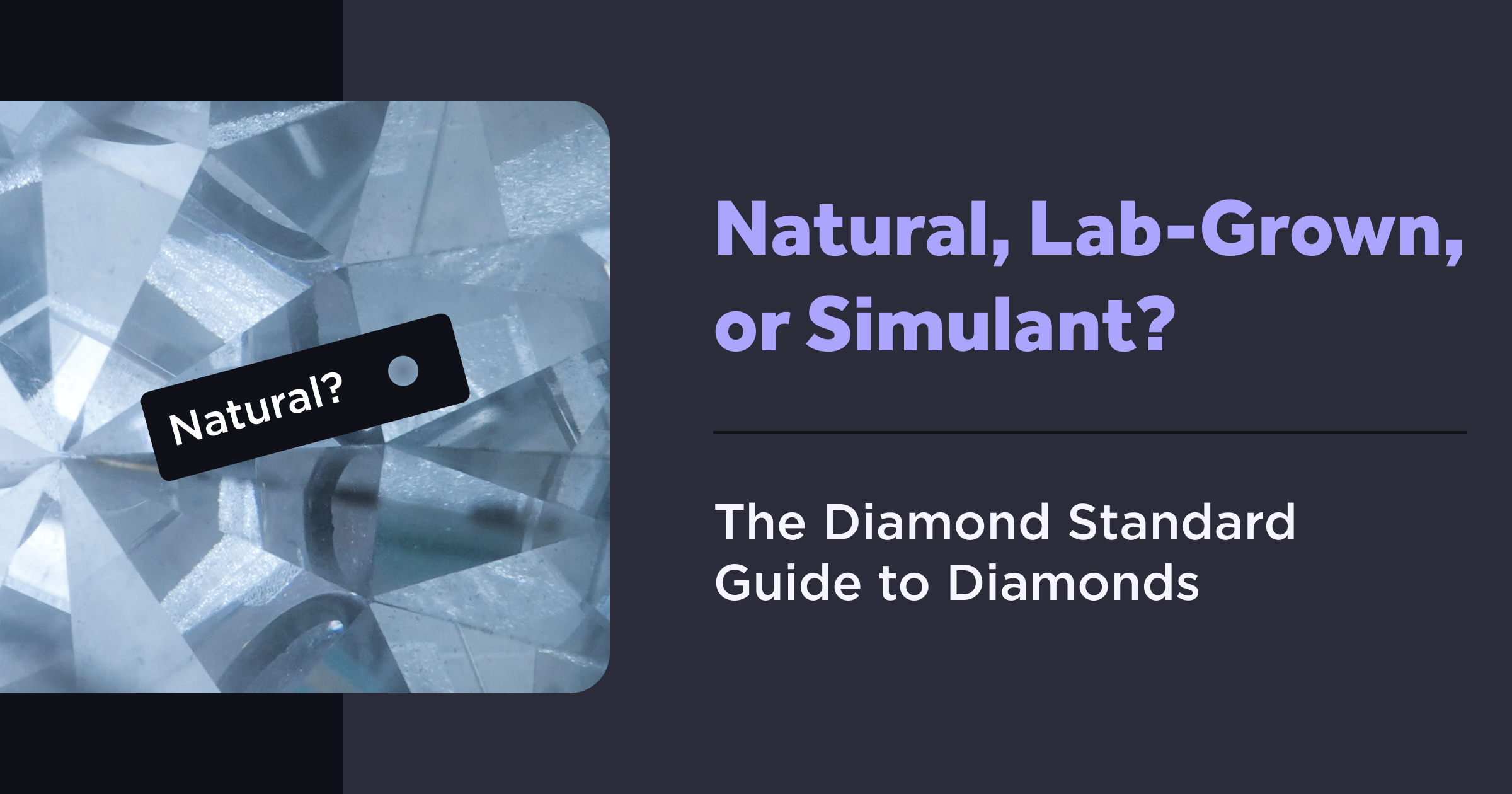When you think of diamonds, what immediately comes to mind?
Is it engagement rings and fairytales, or investable assets and mining?
Diamonds have been around since the fourth century BC. Every natural diamond is immensely old, formed long before dinosaurs roamed the earth. The youngest diamond is 900 million years old, and the oldest is 3.2 billion years old. As the stones made their way through different centuries, periods, and cultures, unique myths, legends, and even superstitions were created and passed down.
In our mission to bring investable diamond commodities to the broader market, Diamond Standard has encountered some common myths that have proven persistent – and which, without a more informed perspective, sometimes hold investors back from realizing the full benefits of these popular stones as investable assets.
Here are some of the biggest myths – and the truth behind the misconceptions.

MYTH #1: De Beers Controls the Diamond Market
TRUTH: De Beers Is a Leader Among Many Others
De Beers Consolidated Mines Limited was the first company to mine and sell diamonds at a significant scale. The company created the original large-scale diamond mine in South Africa, monopolized distribution of the stone, and then went on to build a highly successful marketing campaign making diamonds the global stone of choice in engagement rings. As we know, engagement rings are now synonymous with diamonds, with millions of consumers convinced that such rings should incorporate the stones.
While De Beers introduced diamonds to the global market and polished the stone’s image to gain engagement and exclusivity, De Beers’ monopoly on diamonds has largely eroded today. Starting in 2000, diamond producers from various regions began distributing diamonds independently of the De Beers channel. This shift improved market dynamics, fostering increased competition, fragmentation, transparency, and liquidity. As a result, De Beers' market share in rough diamonds has permanently declined to approximately 29% in recent years, down drastically from the 90% it controlled in the 1900s.
According to Rapaport, 124 companies are buying from De Beers, Alrosa, Rio Tinto and Dominion. “Between them, they’re supplying 124 diamond companies, many of which are buying from multiple sources. Among those companies, 41 are headquartered in India, 38 in Belgium, followed by Israel with 15, seven in each of Russia and the U.S., and six based in Hong Kong.”
Conclusion: A Decentralized Diamond Market is in Place
While De Beers' legacy in establishing the diamond market and shaping its narrative remains undeniable, its control over the industry is now a relic of the past. The decentralized reality, with diverse players across the globe, ensures that no single entity dictates diamond prices or their cultural significance. Consumers today have more information, more options, and greater power to decide the role diamonds play in their lives. The diamond market, once a tightly controlled landscape, has blossomed into a dynamic ecosystem driven by competition, transparency, and evolving consumer trends. This shift not only democratizes access to diamonds but also opens the door for innovation and ethical sourcing practices, promising a brighter future for this enduring symbol.

MYTH #2: Lab-Grown Diamonds Are a Good Investment
TRUTH: Lab-Grown Diamonds Do Not Hold Their Value Over Time
A prevalent myth in today's diamond market is that lab-grown diamonds represent a sound investment opportunity. This belief stems from their increasing availability and their appeal as a more affordable and ethical alternative to natural diamonds. However, when we delve into the financial aspects and market trends, a different story unfolds.
The Decline in Lab-Grown Diamond Prices
The price trajectory of lab-grown diamonds over recent years paints a telling picture. From Q4 2016 to Q1 2023, the price of a standard 1.5 Carat, Round, VS-Clarity, Near-Colorless lab-grown diamond plummeted by a staggering 76.9%. This decline is attributed to an oversupply in the market and the decreasing costs of manufacturing these diamonds. In stark contrast, natural diamonds have shown resilience in value, with a price increase of 12.4% during the same period.
Supply and Demand Dynamics
The fundamental economic principle of supply and demand plays a crucial role in the diamond market. The ease of manufacturing lab-grown diamonds has led to a significant increase in their supply, outpacing demand and thereby driving down prices. Natural diamonds, however, remain scarce and difficult to mine, which sustains their value over time.
Long-term Investment Perspective
From an investment perspective, stability and potential for appreciation in value are key. The declining price trend of lab-grown diamonds suggests a lack of long-term investment stability. In contrast, natural diamonds have not only retained their value but have also seen a steady increase since November 2023, making them a more reliable choice for investors seeking assets that hold or appreciate over time.
Conclusion: Investment Potential of Natural vs. Lab-Grown Diamonds
When considering diamonds as an investment, it's crucial to look beyond the initial affordability of lab-grown diamonds and consider the long-term financial implications. The declining value of lab-grown diamonds challenges their status as a sound investment, whereas natural diamonds' enduring value makes them a more attractive option for those looking to invest in the diamond market.
Interested in investing in diamonds with lasting value? Connect with Diamond Standard for opportunities in natural diamond investments: Schedule a Meeting. How do you view the long-term investment potential of natural diamonds compared to lab-grown alternatives?

MYTH #3: Natural Diamonds Are Unethically Produced
TRUTH: Natural Diamonds Have Stringent Regulations and a Positive Impact on Producing Countries
The Kimberley Process: A Game-Changer in Diamond Ethics
The Kimberley Process, established in 2003 under the aegis of the United Nations and the World Trade Organization, revolutionized the ethics of diamond production. This certification scheme was specifically designed to prevent the trade in conflict diamonds, which are diamonds mined to fund armed conflict against governments. As a result of this process, conflict diamonds now constitute less than 1% of the global rough diamond trade. Furthermore, vendors producing 99.8% of the world's rough diamonds comply with the Kimberley Process, ensuring that the majority of natural diamonds on the market are conflict-free.
Natural Diamond Council and GIA: Advocates for Ethical Production
Organizations like the Natural Diamond Council (NDC) and the Gemological Institute of America (GIA) have been instrumental in promoting ethical practices in diamond production. The NDC works tirelessly to dispel myths about diamonds and provides transparent information about the positive impacts of natural diamond mining. These include community development, employment opportunities, and environmental stewardship in mining regions. On the other hand, the GIA is renowned for its rigorous standards in diamond grading and certification, contributing to the integrity and transparency of the diamond industry.
Socio-Economic Benefits in Producing Countries
The impact of diamond mining on producing countries, especially in Africa, is significant and largely positive. Countries like Botswana and South Africa have seen transformative economic growth due to diamond mining. The revenue from natural diamonds has funded infrastructure, healthcare, education, and other critical services, drastically improving the quality of life in these regions.
Conclusion: Ethical, Beneficial, and Sustainable
In summary, the modern natural diamond industry is characterized by its ethical production practices, stringent regulations, and positive socio-economic impacts. As investors and consumers, it's crucial to recognize these facts and understand the role that natural diamonds play in the global economy and the upliftment of mining communities.
The diamond industry's commitment to ethical production not only reassures consumers and investors but also contributes to sustainable development in mining countries. The myth that natural diamonds are unethically produced is outdated and does not reflect the current practices and benefits associated with natural diamond production.
Are you interested in ethically sourced, natural diamonds for investment? Connect with Diamond Standard to explore investment opportunities in this sustainable and ethical asset class: Schedule a Meeting. How do you view the role of natural diamonds in today's world?

MYTH #4: Diamond Prices are Artificially Inflated
TRUTH: Today's Diamond Market Operates on Decentralized Commerce, Driven by Supply, Demand, and Objective Quality Factors.
The longstanding myth that diamond prices are artificially inflated is a misconception that fails to acknowledge the significant evolution of the diamond market. Historically, the diamond industry was largely dominated by De Beers, a company that held an unyielding grip on the market, controlling both supply and prices. This monopoly-like scenario led to the perception that diamond prices were artificially set. However, the landscape of the diamond market has undergone a radical transformation, especially since the early 2000s.
Decentralization and Competition in the Modern Diamond Industry
- Diminished Monopoly Power: The once-dominant position of De Beers has considerably diminished. Their control over the diamond market, which was nearly absolute in the past, has now been replaced by a more balanced and competitive environment.
- Diverse Market Players: Today, the diamond industry is characterized by the presence of multiple mining companies, cutting and polishing centers, wholesalers, and retailers. This diversity in market players ensures that no single entity holds a monopoly over diamond pricing.
- Geographical Diversification in Production: Diamond production has become geographically diverse, with significant contributions from regions like Russia, Canada, and Botswana. This geographical spread in production adds to the stability and diversity of the market.
The Role of Market Forces and Objective Quality Standards
- Supply and Demand: The diamond market now operates under the fundamental economic principles of supply and demand. Prices are influenced by a variety of factors, including consumer preferences, global economic conditions, and cultural trends.
- Objective Quality Assessment: The value of diamonds is now more transparently assessed based on objective criteria. The universally accepted 4Cs (carat, cut, clarity, and color), as established by independent gemological institutes like the Gemological Institute of America (GIA) and the International Gemological Institute (IGI), play a pivotal role in determining a diamond's value. This system ensures that diamond valuation is based on tangible, measurable characteristics rather than subjective or arbitrary factors.
- Global Networks and Associations: Organizations such as the World Federation of Diamond Bourses (WFDB) with over 28,000 members represent a vast network of independent diamond dealers worldwide. The presence of such organizations further promotes market competition and enhances price transparency.
Conclusion: A Free Market System at Work
The transition from a monopolistic to a decentralized market structure in the diamond industry exemplifies the principles of a free market system. This shift has led to more realistic, market-driven pricing that reflects the true value of diamonds, based on objective quality standards and global market forces. The modern diamond market, characterized by its transparency, diversity, and competitive nature, effectively dispels the myth of artificially inflated diamond prices.
Do you think this new market dynamic has made diamonds a more appealing investment option?

MYTH #5: Diamonds Are Not Rare
TRUTH: Diamonds are Very Hard to Find and Production is Diminishing
A prevalent myth in the diamond market is that diamonds are abundant and easily accessible. This misconception is often fueled by the regular appearance of diamonds in jewelry stores and the emergence of lab-grown diamonds. However, the reality of diamond rarity is far more complex and rooted in geological processes and current mining trends.
Geological Rarity: A Billion-Year Process
Natural diamonds are formed deep within the Earth's mantle, under extreme conditions of intense pressure and heat, throughout one to three billion years. This geological rarity is underscored by the Gemological Institute of America (GIA), which explains that the unique formation process of diamonds contributes to their scarcity and value. The individual journey of each diamond, from its formation to its emergence at the Earth's surface, is a testament to its rare and precious nature.
Diminishing Resources: The Decline of Diamond Mines
The rarity of natural diamonds is further highlighted by the current state of diamond mining. Many of the world's largest and most productive diamond mines are approaching the end of their life span. For instance, the Argyle mine in Australia, famous for its pink diamonds, ceased operations in 2020. Additionally, major mines in Russia and Africa are also projected to close within the next decade, leading to a significant reduction in global diamond production. According to industry reports, diamond production has been in decline, with a noticeable drop in discoveries and mine openings, signaling a future where natural diamonds will become increasingly rare.
Market Implications: Rising Demand and Limited Supply
The decreasing availability of natural diamonds is poised to impact the market significantly. As existing mines deplete their resources and fewer new mines are discovered, the supply of natural diamonds will continue to shrink. This diminishing supply, coupled with a consistent demand for these gems, particularly in emerging markets, is likely to lead to an increase in the value of natural diamonds. The rarity of natural diamonds is not just a result of their billion-year formation but also a consequence of the limited, finite nature of global diamond reserves.
Conclusion: The Enduring Rarity and Value of Natural Diamonds
The rarity of natural diamonds is a multifaceted issue that encompasses their unique geological formation and the current state of diamond mining. The decreasing number of operational mines and the complex process required to form diamonds contribute to their inherent rarity and value. This understanding dispels the myth of diamond abundance and reaffirms natural diamonds' status as a precious and finite resource.
Interested in investing in rare, natural diamonds? Connect with Diamond Standard for opportunities to invest in these scarce and valuable gems: Schedule a Meeting. How do you perceive the rarity and value of natural diamonds in today's market?




